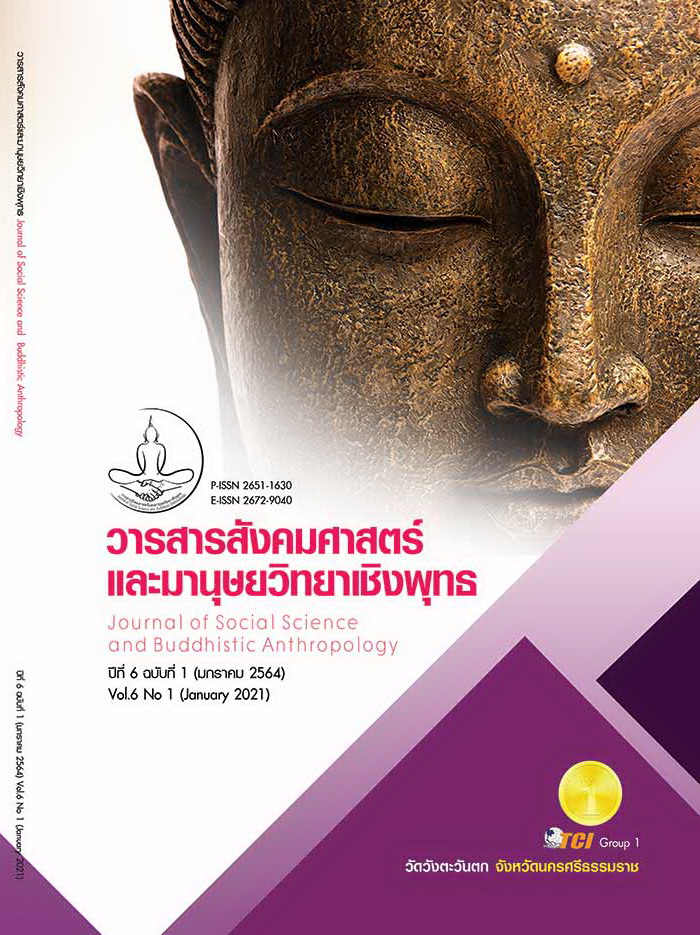USING SPEECH ACTS IN DHAMMA’ BOOKS VIPASSNA ISAN FOR TEACHING MONKS
Keywords:
Using Speech Acts, Dhamma Books for Teaching Monks, Vipassana Isan MonksAbstract
The objective of this research article 1) To investigate types of speech acts in Dhamma Books of Vipassana Isan teaching monks. 2) To investigate sub -types of speech acts in Dhamma Books of Vipassana Isan teaching monks. The author collected the data about these Dhamma Books of Vipassana Isan teaching monks 5 Books. The author applied the classification criteria of types of Speech Acts created by John R. Searle (1976) and adapt it as a guildline in this research. The findings of study showed that 5 main groups of speech acts, 18 speech acts in Dhamma Books of Vipassana Isan teaching monks as follows : 1) Directives Speech Acts 75.44% 2) Representatives Speech Acts 21.57% 3) Expressives Speech Acts 1.70 % 4) Commissive Speech Acts 0.97% 5)and the one found least was Declarative Speech Acts 0.32%. The findings of study showed that the sub-types acts as investigated from the specific meanings of sentence could be divided into sub - types of speech acts, Directives Speech Acts 3 sub - types example speech acts of teaching, speech acts of told to do, speech acts of advice,Representatives Speech Acts 6 sub-types example speech acts of affirmative, speech acts ofblaming, speech acts of start the story, speech acts of end the story, speech acts of ask-answer, speech acts of narrative. Expressives Speech Acts 3 sub-types example speech acts of opinion, speech acts of encouraging, speech acts of congratulations,Commissive Speech Acts 5 sub-types example speech acts of wishing , speech acts of warning, speech acts of request, speech acts of contract, speech acts of blessing and Declarative Speech Acts 1 types example speech acts of declaring And the analysis of speech acts classified as 3 ideologies example Ideology of religious leaders, Ideology of leaders using persuasion, Ideology of social group
References
กฤษดาวรรณ หงศ์ลดรมภ์ และธีรนุช โชคสุวณิช. (2551). วัจนปฏิบัติศาสตร์. กรุงเทพมหานคร: โรงพิมพ์แห่งจุฬาลงกรณ์มหาวิทยาลัย.
ณัฐวดี คมประมูล และคณะ. (2561). วัจนกรรมในการให้คำปรึกษาเรื่องความรักในคอลัมน์คนดังนั่งเขียนของดีเจพี่อ้อย. ใน Proceedings การประชุมหาดใหญ่วิชาการระดับชาติและนานาชาติ ครั้งที่ 9. มหาวิทยาลัยหาดใหญ่.
พระโพธิญาณเถร (ชา สุภทฺโท). (2546). 48 พระธรรมเทศนา. กรุงเทพมหานคร: รุ่งศิลป์การพิมพ์.
พระธรรมวิสุทธิมงคล (บัว ญาณสมฺปนฺโน). (2552). เข้าสู่แดนอวกาศของจิตของธรรม. กรุงเทพมหานคร: พรีมาพับบลิชชิง จำกัด.
พระมหาวิชาญ สุวิชาโน. (2542). ศึกษากระบวนการฝึกอบรมบุคลากรทางพระพุทธศาสนาของพระโพธิญาณเถระ (ชา สุภทฺโท). ใน วิทยานิพนธ์พุทธศาสตรมหาบัณฑิต สาขาธรรมนิเทศ. มหาวิทยาลัยมหาจุฬาลงกรณราชวิทยาลัย.
พระราชนิโรธรังสีคัมภีรปัญญาวิศิษฏ์ (เทสก์ เทสรํสี). (2539). รวมโอวาทหลังปาฏิโมกข์. กรุงเทพมหานคร: บุญศิริการพิมพ์.
วินัย ผลเจริญ. (2562). การปฏิบัติกรรมฐานตามแนวของหลวงพ่อเทียน จิตฺตสุโภ. ใน วินัย ผลเจริญ (บรรณาธิการ), รวมบทความพุทธศาสนากับสังคมและการเมือง (หน้า 47-105). มหาสารคาม: อภิชาติการพิมพ์.
วิระวัลย์ ดีเลิศ และปณัฐ อนุรักษ์ปรีดา. (2562). วาทกรรมคำสอนของพระพรหมมังคลาจารย์ (ปัญญานันทภิกขุ). วารสารสถาบันวิจัยญาณสังวร, 2(10), 116-131.
ศุภรัตน์ แสงฉัตรแก้ว. (2557). กลวิธีทางภาษาเพื่อแสดงอำนาจในสุนทรพจน์ของจอมพลสฤษดิ์ ธนะรัชต์. ใน อมรา ประสิทธิ์รัฐสินธุ์ (บรรณาธิการ), ภาษากับอำนาจ : บทความจากการประชุมวิชาการ (หน้า 326-360). กรุงเทพมหานคร: โรงพิมพ์แห่งจุฬาลงกรณ์มหาวิทยาลัย.
หลวงปู่ฝั้น อาจาโร. (2558.). วิปัสสนาสมาธิภาวนารักษาใจ. กรุงเทพมหานคร: ธรรมสภา.
หลวงปู่มั่น ภูริทตฺโต. (2558.). กรรมฐาน 40 สมาธิแบบพระพุทธเจ้า. กรุงเทพมหานคร: ธรรมสภา.
อานันตพร จินดา. (2549). กลยุทธ์ด้านสาระและการเล่าเรื่องในงานเขียนอิงธรรมะของดังตฤณ. ใน วิทยานิพนธ์นิเทศศาสตรมหาบัณฑิต สาขาวิชานิเทศศาสตรพัฒนาการ. จุฬาลงกรณ์มหาวิทยาลัย.
Alkhirbash, A. (2016). Speech acts as persuasive devices in selected speeches of Dr. Mahathir Mohammed. International Journal of English and Education, 5(2), 81-103.
Searle, J. R. (1976). The classification of illocutionary acts. Language in Society, 5(2), 1-23.
Stanley, T. J. (1984). The Buddhist Saint of Forest and the cult of Amulet : A study in Charisma, Hagiography, and Millennial Buddhism. Cambridge: Cambridge University Press.








